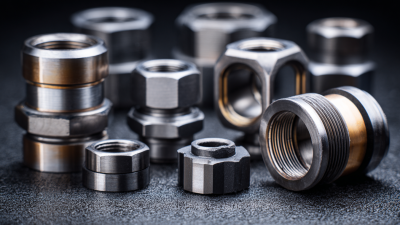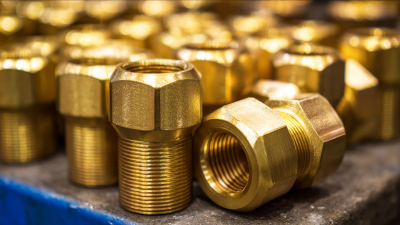Mastering Stainless Steel Pipe Fittings: A Comprehensive Tutorial on Selection and Application
In the ever-evolving landscape of construction and manufacturing, the demand for durable and reliable materials has never been more critical. Stainless Steel Pipe Fittings stand out as a premier choice due to their exceptional resistance to corrosion, high temperatures, and pressure variations. According to a recent report by Grand View Research, the global market for stainless steel pipe fittings is expected to reach USD 16.9 billion by 2025, growing at a compound annual growth rate (CAGR) of 4.6%. This growth is driven by the increasing adoption of stainless steel in various sectors, including oil and gas, food processing, and chemical manufacturing. Understanding the benefits and applications of Stainless Steel Pipe Fittings is essential for professionals in these industries, as it ensures the selection of the right materials that enhance efficiency and longevity in systems where reliability is paramount. This tutorial aims to provide a comprehensive overview of the critical factors in selecting and applying these versatile components.

Understanding the Different Types of Stainless Steel Pipe Fittings and Their Uses
Stainless steel pipe fittings are essential components in various industries due to their durability, resistance to corrosion, and aesthetic appeal. According to the Global Stainless Steel Pipe and Fittings Market Report, the demand for stainless steel fittings is projected to grow at a CAGR of 6.5% from 2021 to 2028, driven by advancements in construction and manufacturing sectors. Understanding the different types of stainless steel fittings, such as elbows, tees, reducers, and flanges, is crucial for selecting the right fitting for specific applications.
Elbows are designed to change the direction of flow within a piping system and are available in varying angles, typically 45 and 90 degrees. Tees are used to create branches in piping, facilitating connection from multiple sources. Reducers are critical for connecting pipes of various diameters, enabling efficient fluid flow. The choice of fittings is governed by factors such as pressure requirements, flow characteristics, and the chemical nature of the transported fluids. Industry standards, including ASME B16.9 and B16.28, provide essential guidelines for the selection and application of these fittings, ensuring safety and performance benchmarks are met across applications.
Mastering Stainless Steel Pipe Fittings: A Comprehensive Tutorial on Selection and Application
| Fitting Type | Description | Common Applications | Material Grade |
|---|---|---|---|
| Elbow | Used to change the direction of pipes. | Plumbing, HVAC systems. | 304, 316 |
| Tee | Connects three pipes; allows branching. | Water supply lines, fire systems. | 304, 316 |
| Reducer | Changes the diameter of the pipe. | Pumping systems, industrial applications. | 304, 316 |
| Cap | Closes off a pipe end. | Pressure vessels, end of lines. | 304, 316 |
| Union | Allows easy disconnection of pipes. | Maintenance applications, piping systems. | 304, 316 |
Key Factors to Consider When Selecting Stainless Steel Pipe Fittings
When selecting stainless steel pipe fittings, several key factors must be taken into account to ensure optimal performance and durability. Firstly, understanding the specific environment where the fittings will be used is crucial. Consider factors such as temperature variations, exposure to chemicals, and pressure levels. Different grades of stainless steel, such as 304 and 316, offer varying levels of corrosion resistance, making it essential to choose the right material based on the working conditions.
Another important aspect is the fitting size and compatibility with existing pipes. Proper sizing ensures a secure fit and prevents leaks, while compatibility with different piping systems or materials can significantly affect the overall integrity of the installation. Additionally, it’s vital to consider the intended application; whether it’s for residential plumbing, industrial use, or food processing, each application might require specialized fittings. By combining these considerations—environment, fitting size, and application requirements—you can confidently select the right stainless steel pipe fittings for your project.
Key Factors Affecting the Selection of Stainless Steel Pipe Fittings
Best Practices for Installing Stainless Steel Pipe Fittings Efficiently
Installing stainless steel pipe fittings efficiently requires a solid understanding of both the materials and installation techniques. According to the American Society of Mechanical Engineers (ASME), over 50% of pipeline failures are attributed to improper fitting installations. To mitigate this risk, it is crucial to ensure that all surfaces are clean and free of contaminants before installation. Additionally, using the right tools, such as torque wrenches, can help achieve the correct tightness without over-torquing, which could lead to stress fractures.
**Tip 1:** Always check the manufacturer's specifications for the fittings you are using. Adhering to these guidelines will ensure compatibility and optimal performance in your particular application.
Furthermore, the International Organization for Standardization (ISO) emphasizes the importance of proper alignment when connecting fittings. Misalignment can cause uneven stress distribution, leading to leaks or failures. Using alignment tools can help maintain consistency and ensure that each component fits seamlessly.
**Tip 2:** Consider using thread sealants or Teflon tape for threaded connections. This can provide an additional layer of protection against leaks and enhance the longevity of your installations.
By implementing these best practices, you can significantly reduce the likelihood of issues arising from improper installation, while also enhancing the durability and efficiency of your stainless steel piping systems.

Common Challenges in Stainless Steel Pipe Fitting Applications and Solutions
When it comes to stainless steel pipe fitting applications, several challenges can arise that practitioners must navigate to ensure optimal performance. One of the primary concerns is corrosion resistance, especially in environments with high temperatures or in the presence of aggressive chemicals. Corrosion can significantly compromise the integrity of fittings, leading to leaks and system failures. It is essential to select fittings made from high-quality stainless steel alloys specifically designed for the intended environment. Additionally, proper installation techniques can mitigate many issues associated with corrosion.

Another common challenge in using stainless steel pipe fittings is the difficulty in achieving reliable connections. Inadequate sealing or misalignment can lead to leaks and inefficiencies. Utilizing advanced technologies, such as precision flow meters and innovative joining solutions, can enhance the reliability of these connections. Furthermore, the rise of artificial intelligence and smart automation tools is redefining how industries approach these challenges, offering insights that can optimize the selection and application of stainless steel fittings in various sectors, including the rapidly growing steel casting market driven by infrastructure demands.
Maintenance Tips for Ensuring Longevity of Stainless Steel Pipe Fittings
When it comes to maintaining stainless steel pipe fittings, regular inspection and cleaning are key to ensuring their longevity and performance. Over time, factors such as corrosion, dirt buildup, or exposure to harsh chemicals can compromise the integrity of these fittings. To initiate this process, inspect the fittings for any signs of rust or stains. If detected, a gentle scrub with a soft brush and a mixture of warm water and mild detergent can effectively restore their appearance without causing damage.
In addition to routine cleaning, proper lubrication is crucial for maintaining the joints and connections of stainless steel pipe fittings. Applying a suitable lubricant can reduce friction and prevent wear, ensuring a smooth operational flow. Furthermore, during installation, it is important to avoid over-tightening, as this can lead to stress fractures or leaks down the line. By following these maintenance tips, you can significantly extend the life of your stainless steel pipe fittings, ensuring that they remain reliable components in your piping system for years to come.
Related Posts
-

The Future of Quick And Easy Fittings: Revolutionizing Efficiency in Industrial Solutions
-

The Future of Innovation in Ball Valve Technology
-

The Future of Best Compression Fittings Revolutionizing Global Supply Chains
-

Ultimate Guide to PVC Pipe Fittings: Understanding Specifications and Industry Trends for Optimal Selection
-

Discover Innovative Examples of Quick And Easy Fittings Solutions
-

7 Essential Tips for Sourcing High-Quality Brass Elbows in Today's Global Market
